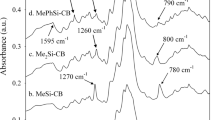Abstract
Purpose. To assess differences in surface energy due to processing induced disorder and to understand whether the disorder dominated the surfaces of particles.
Methods. Inverse gas chromatography was used to compare the surface energies of crystalline, amorphous, and ball milled lactose.
Results. The milling process made ca 1% of the lactose amorphous, however the dispersive contribution to surface energy was 31.2, 37.1, and 41.6 mJ m−2 for crystalline, spray dried and milled lactose, respectively. A physical mixture of crystalline (99%) and amorphous (1%) material had a dispersive surface energy of 31.5 mJ m−2.
Conclusion. Milling had made the surface energy similar to that of the amorphous material in a manner that was very different to a physical mixture of the same amorphous content. The milled material will have similar interfacial interactions to the 100% amorphous material.
Similar content being viewed by others
REFERENCES
A. A. Elamin, C. Ahlneck, G. Alderborn, and C. Nystrom. Increased metastable solubility of milled griseofulvin depending on the formation of disordered surface structure. Int. J. Pharm. 111:159–170 (1994).
J. C. Feeley, P. York, B. S. Sumby, and H. Dicks. Determination of surface properties and flow characteristics of salbutamol sulphate, before and after micronisation. Int. J. Pharm. 172:89–96. (1998).
M. D. Ticehurst, R. C. Rowe, and P. York. Determination of the surface properties of two batches of salbutamol sulphate by inverse gas chromatography. Int. J. Pharm. 111:241–249. (1994).
M. D. Ticehurst, P. York, R. C. Rowe, and S. K. Dwivedi, Characterisation of the surface properties of α–lactose monohydrate with inverse gas chromatography, used to detect batch variation. Int. J. Pharm. 141:93–99 (1996).
J. W. Dove, G. Buckton, and C. Doherty. A comparison of two contact angle measurement methods and inverse gas chromatography to assess the surface energies of theophylline and caffeine. Int. J. Pharm. 138:199–206 (1996).
P. York, M. D. Ticehurst, J. C. Osborn, R. J. Roberts, and R. C. Rowe. Characterisation of the surface energetics of milled dl–propranolol hydrochloride using inverse gas chromatography and molecular modelling. Int. J. Pharm. 174:179–186. (1998).
I. M. Grimsey, M. Sunkersett, J. C. Osborn, P. York, and R. C. Rowe. Interpretation of differences in the surface energies of two optical forms of mannitol by inverse gas chromatography and molecular modelling. Int. J. Pharm. 191:43–50 (1999).
N. M. Ahfat, G. Buckton, R. Burrows, and M. D. Ticehurst. An exploration of inter relationships between contact angle, inverse phase gas chromatography and triboelectric charging. Eur. J. Pharm. Sci. 9:271–276 (2000).
D. A. Butler, C. Levoguer, and D. R. Williams. Apparatus and a method for investigating the properties of a solid material by inverse chromatography, International patent application PCT/GB99/03328 (1999).
G. Buckton and P. Darcy. Assessment of disorder in crystalline powders — A review of analytical techniques and their application. Int. J. Pharm. 179:141–58 (1999).
G. Buckton, P. Darcy, and A. J. Mackellar. The use of isothermal microcalorimetry in the study of small degrees of amorphous content of powders. Int. J. Pharm. 117:253–256 (1995).
S. K. Dwivedi and A. G. Mitchell. Gas chromatographic analysis of anomeric composition of lactose. J. Pharm. Sci. 78:1055–1056 (1989).
O. C. Chidavaenzi, G. Buckton, F. Koosha, and R. Pathak. The use of thermal techniques to assess the impact of feed concentrations on the amorphous content and polymorphic forms present in spray driedlactose. Int. J. Pharm. 159:67–74 (1997).
S. E. Hogan and G. Buckton. The quantification of small degrees of disorder in lactose using solution calorimetry. Int. J. Pharm. 207:57–64 (2000).
J. R. Condor and C. L. Young, Physicochemical Measurement by Gas Chromatography, John Wiley and Sons, Chichester, 1979.
J. H. De Boer, The Dynamic Character of Chemisorption, Clarendon press, Oxford, 1953.
C. Kemball and E. K. Rideal. The adsorption of vapours on Mercury 1. Non–polar substances. Proceed. Royal Soc. A 187:53–73 (1946).
J, Schultz, L Lavielle, and C. Martin. The role of the interface in carbon fibre–epoxy composites, J. Adhesion 23:45–60 (1987).
Author information
Authors and Affiliations
Rights and permissions
About this article
Cite this article
Newell, H.E., Buckton, G., Butler, D.A. et al. The Use of Inverse Phase Gas Chromatography to Measure the Surface Energy of Crystalline, Amorphous, and Recently Milled Lactose. Pharm Res 18, 662–666 (2001). https://doi.org/10.1023/A:1011089511959
Issue Date:
DOI: https://doi.org/10.1023/A:1011089511959




